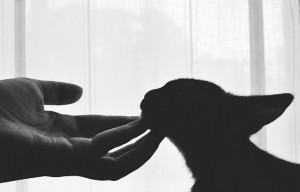This Is Your Brain on Sex
The following is an excerpt from Succulent Sexcraft: Your Hands-On Guide to Erotic Play and Practice:
 Your neocortex is the executive headquarters of your brain, perched in the penthouse at the front of your skull. This is not where sex takes place. Sexuality is primarily a function of the older, more primitive parts of our brain. Sexual energy is animal energy and our animal selves live in the limbic system and old brain. Sex taps into ancient evolutionary machinery that resides, so to speak, in the cranial basement. You need to go down the brain elevator if you want to really get down sexually.
Your neocortex is the executive headquarters of your brain, perched in the penthouse at the front of your skull. This is not where sex takes place. Sexuality is primarily a function of the older, more primitive parts of our brain. Sexual energy is animal energy and our animal selves live in the limbic system and old brain. Sex taps into ancient evolutionary machinery that resides, so to speak, in the cranial basement. You need to go down the brain elevator if you want to really get down sexually.
Your busy babbling executive forebrain can be more of a hindrance than a help. We’ve probably all had times when our chattering neocortex blocked our sexual energy. People get stuck in their heads—or, rather, neocortex—all the time thinking about things like what you should (or shouldn’t) be doing, if you’re doing it right, if the ceiling needs painting… the list goes on and on.
The simple fact is that to go into erotic trance at all, and especially to go deep, your forebrain needs to turn off so your animal body can wake up and turn on. Your command center needs to stop thinking, deciding, planning, worrying and judging—it needs to go off-line. Until that happens, the primal templates that reside in the old parts of your brain can’t be accessed.
Turning off the jabbering conversations in your executive office is easier said than done. We can do it, though, with the help of our sexcraft toolkit. Focusing on sound and breath, for instance, takes our attention away from all that administrative prattle and brings us to greater body awareness — it makes us, in this sense, more ‘animal.’ Similarly, visualizing heart energy stills the mind and activates the limbic system, which, as we’ve seen, is the mammalian part of the brain that deals with love and attachment.
Great sex brings out the animal in you. not literally, but not merely figuratively either. You go down into the more animal parts of your brain, on vacation from your control-aholic, hyper-active head office.
The deeper we get into our arousal trance, the more difficult it becomes to communicate coherently. talking is a fore-brain activity and when we’re turned on, we’re down in the basement and that upper story is far away. This explains why we tend to communicate in shorthand when we’re having sex (“now!” “please!” “Yes!”) or stay with our animal selves and simply purr and howl.
The three aspects of the brain—the old ‘reptile brain,’ the ‘mammal mid-brain’ and the ultra-modern ‘human new brain’ — can act in coordination or competition. Sex is a great example of how this plays out. It’s a journey where you shift from mundane reality to the altered state of intense arousal. At the beginning of the experience, your prattling neocortex predominates. As you go deeper into arousal, it slowly shuts down, allowing you to descend to where the primeval apparatus of sex resides. In between are the connections, emotions and experiences that form the web of who you are, what turns you on, your dreams and fantasies, your hopes and expectations, your anxieties and fears, your thoughts, sensations, meaning and stories. These can facilitate or inhibit your shift into deep erotic trance. For instance, your command center can assist you on your journey by reminding you to use your tools, advising you to take some deep breaths, make pleasure sounds and rock your hips. You can use your sexual imagination to replace negative thoughts with hot scenarios. Brain management is, believe it or not, a bedroom skill. You don’t want your forebrain working against you. Learn to harness it in service to your arousal—use your conscious brain to get animal and wild.
You can consciously use your brain to change your mind and you can use your mind to change your brain.








